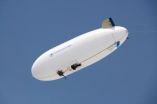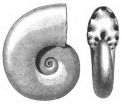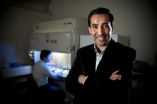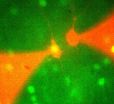(Press-News.org) The number and scale of forest fires has increased dramatically in recent decades. Who can forget last summer's television images of blazing infernos devouring miles and miles of forest in Russia, Australia and California? In Germany, too, several regions are under threat precipitated by climate change – Brandenburg, for example, is one of the areas of Europe that are most at risk.
Often, fires can only be contained from the air. In order to fight them in a targeted way, firefighting planes need to be given precise information on where the flames are at their worst. Infrared (IR) cameras have long been a trusted aid, since fire glows most intensely in the infrared range. IR cameras measure the intensity of the heat radiation emanating from a forest fire, and this leads them to its source. But despite the high-resolution images such cameras produce, they cannot be used to find the source of a fire in very smoky conditions because the dust and smoke severely dim the infrared rays.
Researchers from the Fraunhofer Institute for High Frequency Physics and Radar Techniques FHR in Wachtberg have found a way around this problem by developing a radiometer that can scan fires even when visibility is limited. The radiometric sensor works in the microwave range between 8 and 40 GHz. At these low frequencies, radiation is scattered far less by dust particles than at the high IR frequencies. "Measurements we took during testing showed that the dimming effect was negligible at 22 GHz. Particles of dust and smoke are practically transparent in the microwave range, but the radiation is still strong enough for the source of a fire to be detected. From a height of 100 meters, we were able to locate fires measuring five meters by five meters in low visibility conditions," says Dipl.-Ing. Nora von Wahl of Fraunhofer FHR. For the test flights, the scientist and her team mounted the microwave sensors on the underside of an unmanned airship belonging to the FernUniversität Hagen. "Along with the sensors themselves, the radiometer comprises a calibrating unit, a planar antenna array, and software for recording and visualizing the data," says von Wahl. The system's resolution is determined by the antenna's angular aperture, so it depends on the size of the antenna, the frequency and the distance from the ground. Using an antenna measuring 20 centimeters at its outer rim, operated at a frequency of 22 GHz and from a height of 30 meters, the radiometer can resolve details on the ground to a grid accuracy of 2.6 meters. "The radiometer doesn't give us as much detail as an infrared camera," says the scientist, "but if we increase the size of the antenna we can achieve higher resolution."
The radiometric sensor allows the researchers to locate pockets of fire even behind a curtain of foliage. "After a forest fire, it is often the case that new fires start underground. To find them, firefighters have to go in and dig around by hand. Our radiometer can detect fires below the top layer of earth," says von Wahl. She goes on to explain that the system is principally suited to fire protection with firefighting planes, but could also be used to monitor industrial sites. This would, for instance, enable early detection of smoldering fires at waste incineration plants.
The radiometer, which measures 105 by 150 by 73 millimeters, is currently a prototype. The scientists' aim is to make the device even smaller, and they also want to optimize the antenna. Future designs will be based on microchips.
INFORMATION:
Radiometer finds sources of fire
2011-01-11
ELSE PRESS RELEASES FROM THIS DATE:
No left turn: 'Superstreet' traffic design improves travel time, safety
2011-01-11
The so-called "superstreet" traffic design results in significantly faster travel times, and leads to a drastic reduction in automobile collisions and injuries, according to North Carolina State University researchers who have conducted the largest-ever study of superstreets and their impacts.
Superstreets are surface roads, not freeways. It is defined as a thoroughfare where the left-hand turns from side streets are re-routed, as is traffic from side streets that needs to cross the thoroughfare. In both instances, drivers are first required to make a right turn and ...
Researchers create 'scoring system' for PTEN mutation testing
2011-01-11
Monday, January 10, 2011 – Cleveland – Researchers have discovered a method for more precise identification of individuals who should undergo testing for genetic mutations of the tumor suppressor gene PTEN, which associates with a variety of conditions including several types of cancers. The research has created a diagnostic scoring system that improves on established criteria.
Led by Charis Eng, M.D., Ph.D., Chair of the Genomic Medicine Institute at the Lerner Research Institute of Cleveland Clinic, the study – the largest clinical study to date on the identification ...
Minerals provide better indoor air
2011-01-11
Since the 50s, formaldehyde has been the basic material for many artificial resins and glues used in particleboards and plywood boards. Estimates indicate that more than 85 percent of all wood materials have adhesives containing formaldehyde. This substance escapes from the materials and, along with other sources, pollutes indoor air. This is why numerous ways have been developed to reduce emissions, and the International Agency for Research on Cancer (IARC) of the World Health Organization WHO has even classified formaldehyde as carcinogenic for humans. Thereupon both ...
Social class and changes in mortality from liver cirrhosis over the 20th Century
2011-01-11
A paper describing a dramatic change during the 20th century in England and Wales in the association between social class and mortality from liver cirrhosis features in Alcohol and Alcoholism. While deaths from cirrhosis were more common among higher social classes in the early part of the century, the pattern changed so that deaths from cirrhosis were much more common among the lower social classes by the end of the century. Data on male cirrhosis mortality by social class were obtained from the Registrar General's Decennial Supplements for the years 1921�.
The ...
Researchers show how Alzheimer's plaques lead to loss of nitric oxide in brain
2011-01-11
PITTSBURGH, Jan. 10 – A researcher at the University of Pittsburgh School of Medicine, in collaboration with scientists from the National Institutes of Health (NIH), has discovered that the deadly plaques of Alzheimer's disease interact with certain cellular proteins to inhibit normal signals that maintain blood flow to the brain. Their findings, which could lead to new approaches to treat the dementia, were recently published in Public Library of Science One.
Levels of nitric oxide (NO) – a signaling molecule that helps regulate blood flow, immune and neurological processes ...
Species loss tied to ecosystem collapse and recovery
2011-01-11
PROVIDENCE, R.I. [Brown University] — The world's oceans are under siege. Conservation biologists regularly note the precipitous decline of key species, such as cod, bluefin tuna, swordfish and sharks. Lose enough of these top-line predators (among other species), and the fear is that the oceanic web of life may collapse.
In a new paper in Geology, researchers at Brown University and the University of Washington used a group of marine creatures similar to today's nautilus to examine the collapse of marine ecosystems that coincided with two of the greatest mass extinctions ...
Early investigations promising for detecting metastatic breast cancer cells
2011-01-11
Research by engineers and cancer biologists at Virginia Tech indicate that using specific silicon microdevices might provide a new way to screen breast cancer cells' ability to metastasize.
An image of their work provided to Biomaterials was selected as one of the 12 best biomaterials-related images published in the journal's 2010 catalogue. http://www.elsevierscitech.com/pdfs/Biomaterials_2010.pdf
The Virginia Tech researchers are: Masoud Agah, director of Virginia Tech's Microelectromechanical Systems Laboratory (MEMS) Laboratory in the Bradley Department of Electrical ...
Research identifies drug target for prion diseases, 'mad cow'
2011-01-11
LEXINGTON, Ky. (Jan. 4, 2011) − Scientists at the University of Kentucky have discovered that plasminogen, a protein used by the body to break up blood clots, speeds up the progress of prion diseases such as mad cow disease.
This finding makes plasminogen a promising new target for the development of drugs to treat prion diseases in humans and animals, says study senior author Chongsuk Ryou, a researcher at the UK Sanders-Brown Center on Aging and professor of microbiology, immunology and molecular genetics in the UK College of Medicine.
"I hope that our study ...
Earth: Finding new oil and gas frontiers
2011-01-11
Alexandria, VA – Where to next in the search for oil and gas? EARTH examines several possible new frontiers - including the Arctic, the Falkland Islands, the Levant, Trinidad and Tobago and Sudan - where oil and gas exploration are starting to take hold. One of those places, Sudan, is in the news for other reasons: South Sudan voted yesterday on whether to secede from North Sudan.
But given that South Sudan holds more than 70 percent of Sudan's 5 billion to 6 billion barrels of proven reserves, a lot in this election hinges on oil. If South Sudan does secede, how will ...
Carnegie Mellon researchers identify 'Facebook neurons'
2011-01-11
PITTSBURGH—Carnegie Mellon University researchers have found that within the brain's neocortex lies a subnetwork of highly active neurons that behave much like people in social networks. Like Facebook, these neuronal networks have a small population of highly active members who give and receive more information than the majority of other members, says Alison Barth, associate professor of biological sciences at Carnegie Mellon and a member of the Center for the Neural Basis of Cognition (CNBC). By identifying these neurons, scientists will now be able to study them further ...





